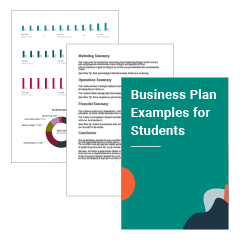

Do you know what’s the most common mistake students and rookie entrepreneurs make while preparing their first business plan?
Of course, it’s the first business plan we’re talking about; there’ll definitely be a few. However, overcomplicating things and failing to consider a business plan example still remain the most common one.
That’s why we decided to come up with a solution. We’ve curated this list of top business plan examples for students to help you get going.
So whether you need a business plan for a college project, start a side hustle, or win a business competition, these examples are just what you need to create business plans that stand out.
Ready to dive in? Let’s start by understanding the key elements of a business plan example:
Business planning is not as complicated of a process as people think it is; they’re just overcomplicating things. (Don’t think so?)
Let’s simplify the key elements that make up a comprehensive business plan; you’ll understand it better that way.
That’s pretty much it about the key elements of a business plan example. Next, let’s explore the best business plan examples for students.
Say goodbye to boring templates
Build your business plan faster and easier with AI assistant
Get 30% off for Students and educators

Now that you already know about the components of a business plan template, let’s review some of the best business plan examples for students.
Upmetrics’ startup business plan example is the ideal solution for students planning to start up or participate in a business plan competition. This business plan template follows the SBA-approved business planning format used by thousands of successful entrepreneurs.
Whether your startup is about a new-age AI-based application, an online shopping site, or traditional IT consulting—this sample business plan is just what you need.
Unlike any traditional small business plan, this example of a startup business plan is lean and agile in approach, focuses on innovation, and emphasizes market validation.
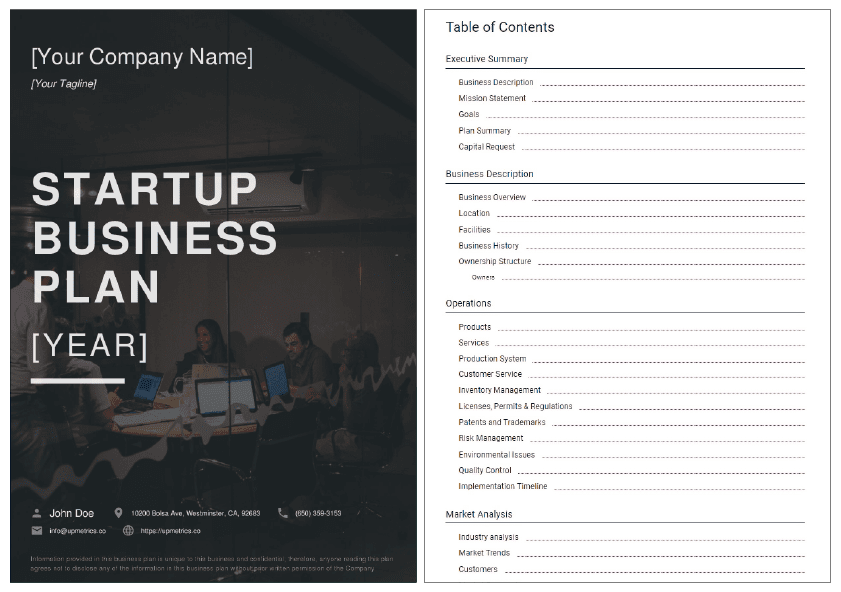
Since you’re transitioning from a student to an entrepreneur, you may not have enough time to spend on creating a detailed business plan. That’s where this lean business plan template can help.
It’s a condensed version of a traditional plan summarizing all its sections with a primary focus on covering only the critical aspects of the business.
This template is best for startups or businesses uncertain about business planning and student-turned-entrepreneurs with limited time and resources to prepare a business plan.
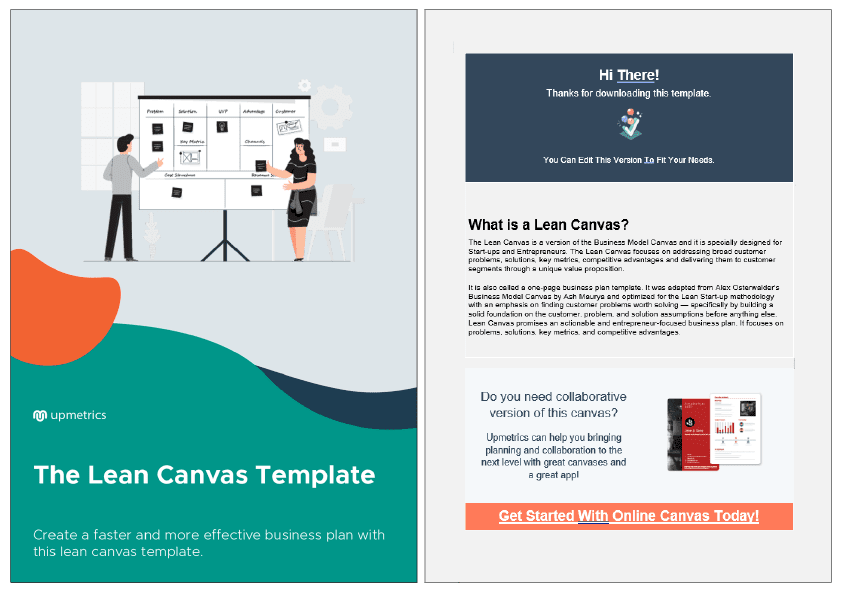
Following an SBA-recommended business plan format is key to securing bank loans and business grants. Since it can be time-consuming to find a template that follows a similar outline as the SBA, this SBA-approved business plan example is the way to get started.
This SBA business plan template has nine primary sections, that include executive summary, company description, market analysis, organization, product description, marketing, funding request, and financial projections.
SBA business plan examples ensure you stay on track and don’t deviate from your funding needs.
As you may have already guessed, a one-page business plan is a one-page version of a traditional business plan. Since it’s a condensed version of a business plan, drafting it can be quite easy and quick compared to a lean or traditional plan.
Employees, partners, and vendors often use one-page business plans as a quick overview of your company and banks and investors as a summary of your operations.
While it may not be the ideal choice for entrepreneurs seeking investment or bank loans, students with side hustles and idea-stage startups can consider this option.
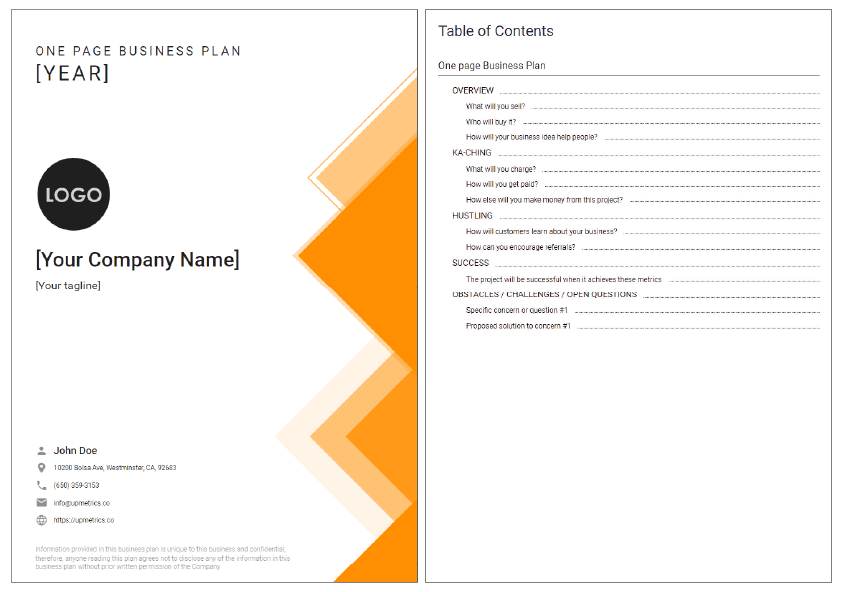
Harvard Business School’s new venture competition selected this sample business plan as a finalist in 2011.
This is a business plan of App Success, a collaborative web-based platform that connects low-income high school seniors with college students from top universities; this business will enable them to collaborate on college selection, college applications, and financial aid applications.
This example can be a great reference for those planning to start a mobile or web-based solution.
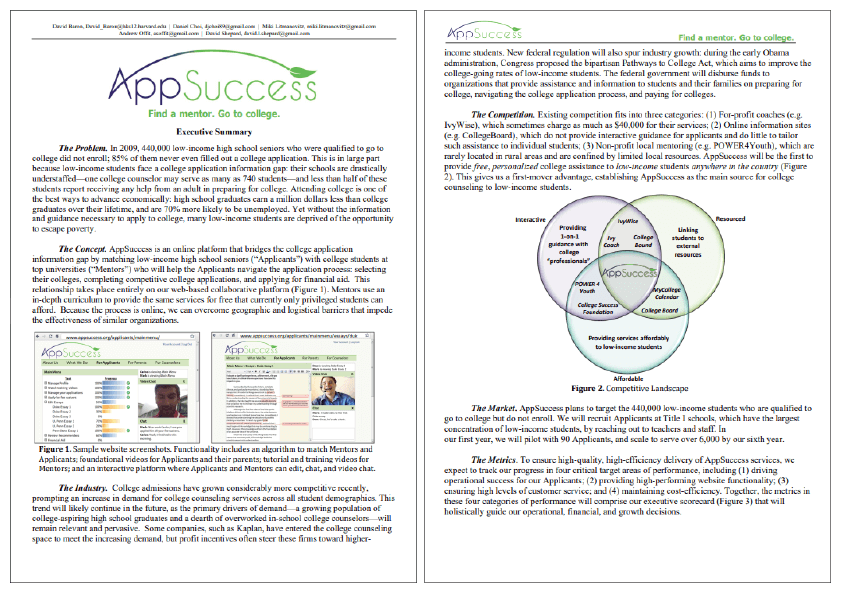
Kean University organizes a business plan competition every year for its students where students prepare and present business plans to compete, and this is one of the sample business plans the University provides to participants to understand the format.
It’s a business plan of Blue Water Boatworks, Inc., a boat detailing and cleaning company specializing in servicing recreational fiberglass and aluminum watercraft.
This example can be a great reference for those planning to start a business related to housekeeping, cleaning, or maintenance.
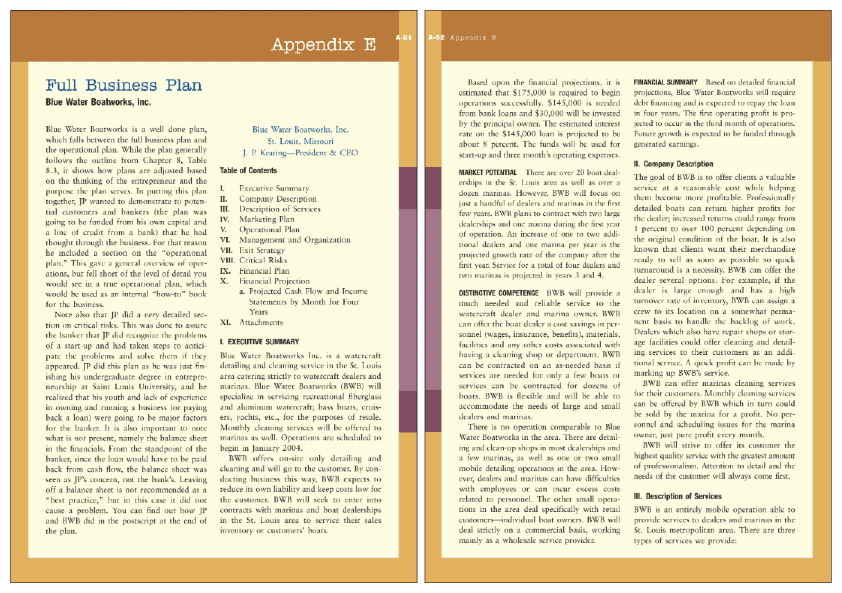
If you are looking for a strategic business plan for a food business, the University of Vermont’s Fancy Foods Business Plan can be a guiding resource for you.
Despite the fact that it can be a good reference for detailed planning, it was written in 1998, so any statistics and numbers may not seem relevant to today’s market landscape. Make sure you keep that in mind.
You may closely follow this example as a reference if planning to start a food truck, restaurant, or any other business that serves food.
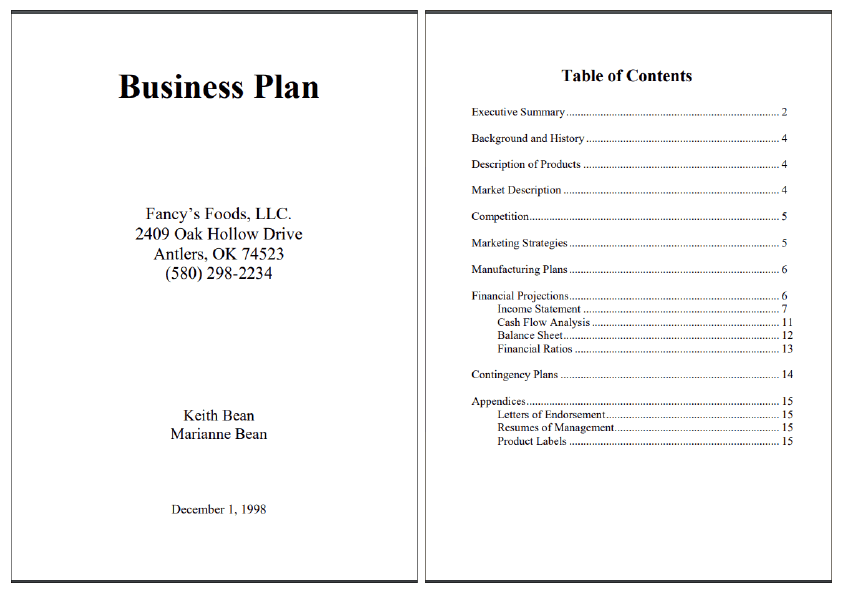
That was the list of best sample business plans for students. However, there’s more to talk about. You now have a business plan example, but what about pitching to investors? Let’s explore free pitch deck examples for students.
Pitching to investors as a first-time founder can be exciting but also overwhelming at times. Worry not; we’ve got a solution—investor pitch templates. We’ve prepared a set of 8 investor pitch templates and examples for students and entrepreneurs to help create winning business pitches.
Whether you need a pitch to find an opportunity, ask for subject matter knowledge, or a problem-solving pitch, these investor pitch examples have got you covered. Download now.
Creating a business plan is no different than creating one for a real business. Similar to how entrepreneurs prepare and present business plans to investors, Students in business plan competitions pitch to judges.
In short, the business planning process remains exactly the same. Let’s discuss how you can write a winning plan to help you win a business plan competition.
Easy as that, that’s the way to write a perfect business plan that can lead you to victory in any business plan competition on planet Earth. Let’s look at an example of a real-life business and financial plan.

Having learned about business planning for students, let’s quickly discuss a coffee shop sample business plan and financial statements prepared using Upmetrics.
The Cooper’s Cup will be a new cafe in Phoenix, Arizona. The 1,500 square foot café will be located in the newly constructed Market Square Plaza on the northeast corner of 135th Street and Mission Street. The anchor tenant, the Price Chopper grocery store, has already taken occupancy, and the excellent location brings more than 10,000 shoppers weekly.
The Cooper’s Cup, aptly named for the aromatic brown liquid that will fill the cup, fills the void of original cafes in the market and stands out from its corporate peers with its fast food concepts and prompt services. The Cooper’s Cup is the alternative to fast food/commercial/coffee shops and offers a much calmer, civilized gourmet coffee experience.
There are no televisions in the cafe, the background music is subtle, and work from local artists will hang on the walls. The restaurant is well-appointed, with overstuffed leather chairs and sofas in a library-like setting. The cafe is reminiscent of times gone by – yet is cutting edge technologically with WIFI and state-of-the-art espresso machines.
The Cooper’s Cup measures its financial success in terms of increased market share and earnings. This is a tremendous opportunity with a total local market of $54 million! The keys to success will be offering quality gourmet coffees, taking advantage of its small size, and relying on an outstanding barista staff.
To achieve these goals, the cafe will present some of the area’s finest gourmet beans from local distributors. Because of its small size, the restaurant can enjoy larger margins through lower overhead. The cafe will hand-select baristas and offer salaries comparable to the chains. The baristas will be trained to cross-sell and sell higher-margin products.
The primary objectives of the business plan for Cooper’s Cup are below:
The Cooper’s Cup is committed to values such as excellence, passion, quality, integrity, and leadership, allowing them to navigate challenges and provide for future opportunities. These core beliefs start with their commitment to their products and their employees. Cooper’s Cup rewards excellence and cherishes loyalty. The cafe will work with its employees to build strong businesses and a secure future.
The Cooper’s Cup is committed to its products and employees, which they believe is the recipe for market success.
The Cooper’s Cup stands out from the competition. Below are their Keys to Success:
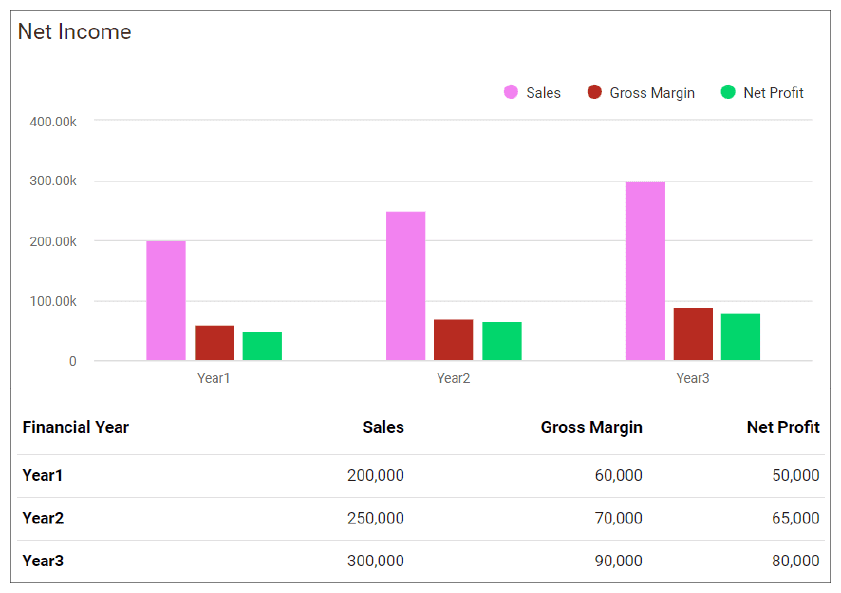
The Cooper’s Cup will be a coffee house/cafe located in Phoenix, Arizona. The cozy cafe will be located in the newly completed Market Square Plaza in the Arizona City area. The cafe will serve gourmet coffee, espresso, drip coffee, lattes, and smoothies. The simple pastry offerings may vary with seasonality, but the primary line will be muffins, bread, cookies, scones, and rolls. All pastries will be supplied daily by a local bakery.
The cafe will be owned and operated by Owen Jones, a veteran restaurateur with several years of experience running and managing chain restaurants. The cafe will be open for business Monday – Thursday 7-10, Fridays and Saturdays, 7-11, and closed Sundays.
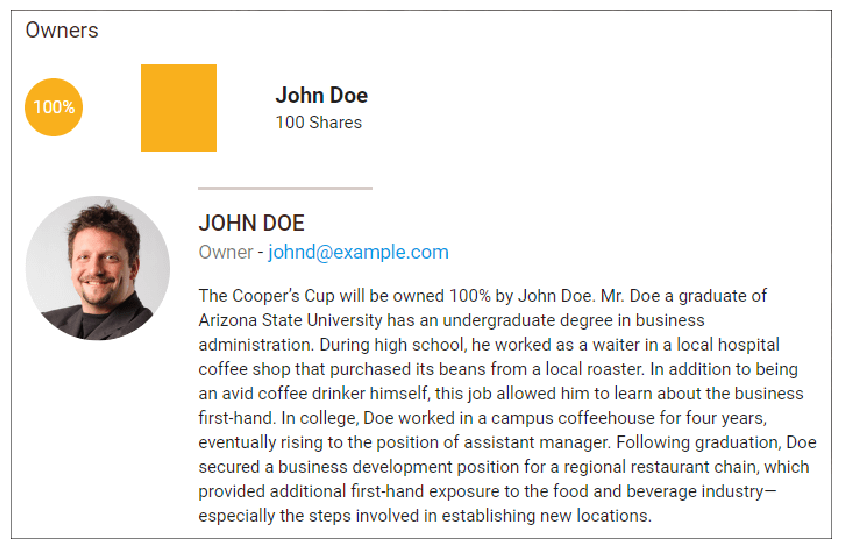
The Cooper’s Cup will be formed as an S-Corporation owned by Mr. Doe.
The Cooper’s Cup will have seating for 40 patrons. The rent is $2,075 a month, with a three-five-year lease available. The site comprises 1500 square feet of leased space consisting of a dining room, a coffee bar, two restrooms, and a storage room in the back.
This storefront needs to be plumbed and wired appropriately to be used as a restaurant. Painting, new floors, and countertops are also needed. A custom coffee bar needs to be built. With materials bought on sale and volunteer labor, the cost to renovate will be $71,725.
The coffeehouse equipment will consist of two commercial espresso machines, air pots and urns, a commercial blender, a commercial brewer, top-loading coffee bins, barista syrups, cold drink dispenser, frothing equipment, a commercial refrigerator, microwave, and stainless steel prep bar.
The cost of the equipment is $38,275. The furniture will consist of leather couches and chairs (purchased at auction), coffee tables, bookcases, and window treatments. The artwork will come from local artists and be sold on a consignment basis. The books were secured via donations. The total cost to furnish is $14,000. Other startup expenses will be dishes, furniture, rent deposit, and marketing.
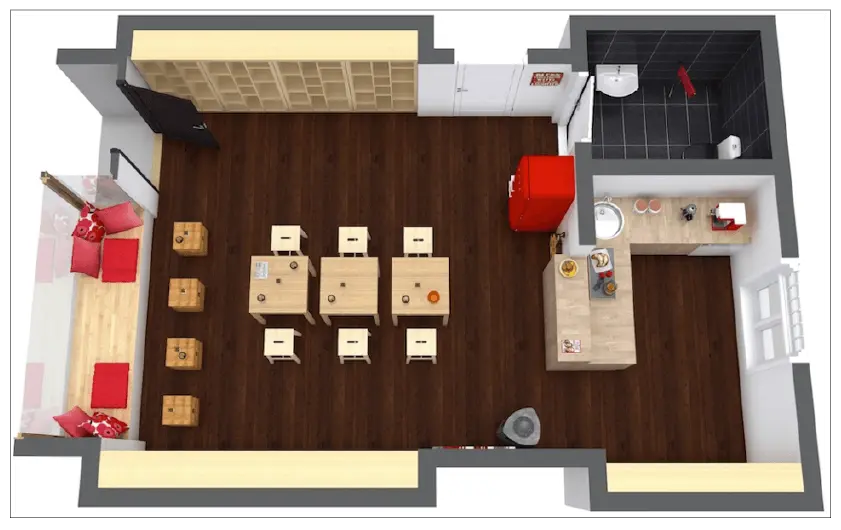
The new coffeehouse is located in the highly desirable Phoenix, Arizona, area at the northeastern intersection of 135th Street and Mission Street in the Newmarket Square Plaza. The property is situated in an excellent location, with an easy 6-minute drive time to I-435 and 69 Highway.
The property is 95% leased with Price Chopper as the Anchor Tenant. Other tenants include LifeSpring Med Spa, Jane’s Canines (Pet Store & Boarding), Pride Cleaners Kahn Dental, and Swim U.
Price Chopper brings more than 10,000 shoppers per week to the center. The location comprises a population of 9,420 within a one-mile radius, 61,102 within a 2-mile radius, and 149,550 within a 5-mile radius – with a median household income of $120,856. Sprint / Nextel’s corporate office is within 2 miles of the site.

Phoenix, Arizona, is an award-winning place to live and work and is considered the leading business community in the Midwest. National publications and organizations recognize Phoenix for its business environment and livability. Here’s a sampling: 6th Place, America’s Best Places to Live Money, Top 50 Cities to Live and Play, National Geographic Adventure, 3rd Hottest Town in the U.S., Money, Among 20 Best Places to Live & Work Employment Review, One of only 72 Sterling Tree Cities in the U.S., National Arbor Day Foundation, Top 10 best Locations to Raise a Family, Southern Business and Development, 1st Place, Kid Friendly Report Card, Population Connection, 2nd Best City in America to Live Business Development Outlook.
Phoenix is at the core of one of the most dynamic local markets in the U.S. It offers easy access to the Arizona City region’s amenities, and, as part of the Arizona City metropolitan area, it is within the most centrally located major market in the nation. I-35, I-435, I-635, and U.S. Highway 69 all pass through Phoenix, and no point in the city is more than 3.5 miles from a freeway. The city maintains an excellent arterial street network and plans to construct additional lane-miles as the area grows. Three airports serve the region. Arizona City International Airport (MCI) is just 25 interstate highway miles north of Phoenix. Johnson County Executive Airport—the second busiest in Arizona—provides complete services for private business jets and general aviation. New Century AirCenter, just 12 miles southwest of the city, offers available aviation services and accommodates cargo or passenger jets of any size.
Phoenix supplies some of the most highly educated workers in the nation, with 97% of Phoenix adults over age 25 holding at least a high school diploma. Johnson County, where Phoenix is located, ranks first among the country’s 231 counties with populations greater than 250,000. The county ranks sixth in the percentage of adults with at least a bachelor’s degree and 16th with a graduate or professional degree.
The Phoenix area has a population of 175,265, based on the 2010 census. The median household income is $77,881, and the median age is 37.9. (2010 U.S. Census)
The U.S. coffee shop industry includes about 20,000 stores with a combined annual revenue of about $10 billion. Major companies include Caribou Coffee, International Coffee & Tea (The Coffee Bean & Tea Leaf), Peet’s Coffee, and Starbucks. The industry is concentrated: the top 50 companies generate more than 70 percent of sales. Coffee shops are part of the specialty eatery industry, including retail outlets specializing in bagels, donuts, frozen yogurt, and ice cream products. (First Research)
Consumer taste and personal income drive demand. The profitability of individual companies depends on the ability to secure prime locations, drive store traffic, and deliver high-quality products. Large companies have advantages in purchasing, finance, and marketing. Small companies can compete effectively by offering specialized products, serving a local market, or providing superior customer service. Specialty eateries, which include coffee shops, are labor-intensive: average annual revenue per worker is about $50,000. Coffee shops compete with convenience stores, gas stations, quick service, fast food restaurants, gourmet food shops, and donut shops. (First Research)
The U.S. coffee shop industry includes about 20,000 stores with a combined annual revenue of about $10 billion. Major companies include Caribou Coffee, International Coffee & Tea (The Coffee Bean & Tea Leaf), Pet’s Coffee, and Starbucks. The industry is concentrated: the top 50 companies generate more than 70 percent of sales. (First Research)
Most adult coffee drinkers said their lifelong habits began during their teenage years. 54% said they began drinking coffee between 13 and 19. Another 22% reported their coffee cravings started between 20 and 24. This means that 76% of adult coffee drinkers began drinking coffee by the time they were 24. So, despite a large amount of marketing and advertising directed at the younger age groups, savvy coffee shop owners will remember to cater some of their offerings to the adult and senior market. (National Coffee Drinking Study).
The Cooper’s Cup will offer a unique experience for coffee enthusiasts by providing a quiet, cozy, yet sophisticated cafe and a sense of refinement and peace in an otherwise hectic and fast-paced world. While other coffee shops cater to convenience with drive-throughs or loud music venues late into the night, the Cooper’s Cup will stand apart from its competitors with its quiet yet soothing ambiance, capturing a truly unique (and much-needed) market niche.
The Cooper’s Cup’s primary offering is gourmet roasted coffees with mocha, carmelicious, white mocha, candy bar latte, and brewed coffee. Complementing the coffee will be a smoothie line including wild berry, strawberry, peach, mango, and lemonade. Rounding out the simple menu line will be pastries obtained from an outside supplier, freshly made and delivered daily. The pastry offerings may vary with seasonality, but the primary line will be muffins, bread, cookies, scones, and rolls.
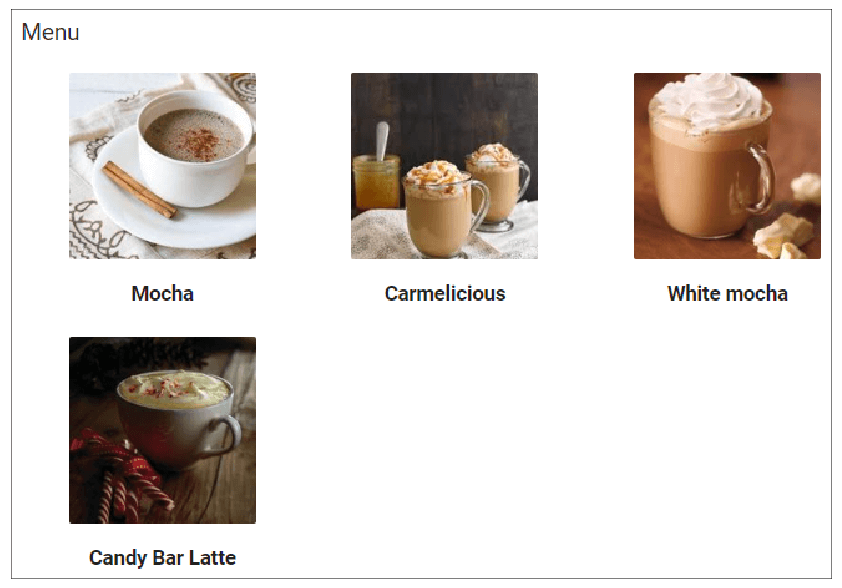
The Cooper’s Cup has negotiated supplier agreements with several local food-service wholesalers and coffee wholesalers in the Phoenix area that have a reputation for quality and reliability:
If one of the abovementioned specialty suppliers cannot meet their needs, the following national suppliers can provide all the food-service products they require. In addition, the following wholesalers will supply the cafe with general restaurant supplies:
Young families, which comprise Phoenix’s third largest market share, are often overlooked in the coffee market. Coffeehouses traditionally have not been considered ‘kid’ friendly. To overcome this hurdle, Cooper’s Cup has long-term plans (5 years) to open a 2nd coffee shop: A combination indoor play area/coffee bar. This concept allows parents and caregivers to meet and relax with other adults while the children can enjoy the indoor playground amenities.
Additional future services will include in-store sales for home purchases and an online store.
The website will have the option to purchase a prepaid gift card program – Prepaid gift cards provide immediate cash, reduce credit card transaction charges, and draw new customers to the business.
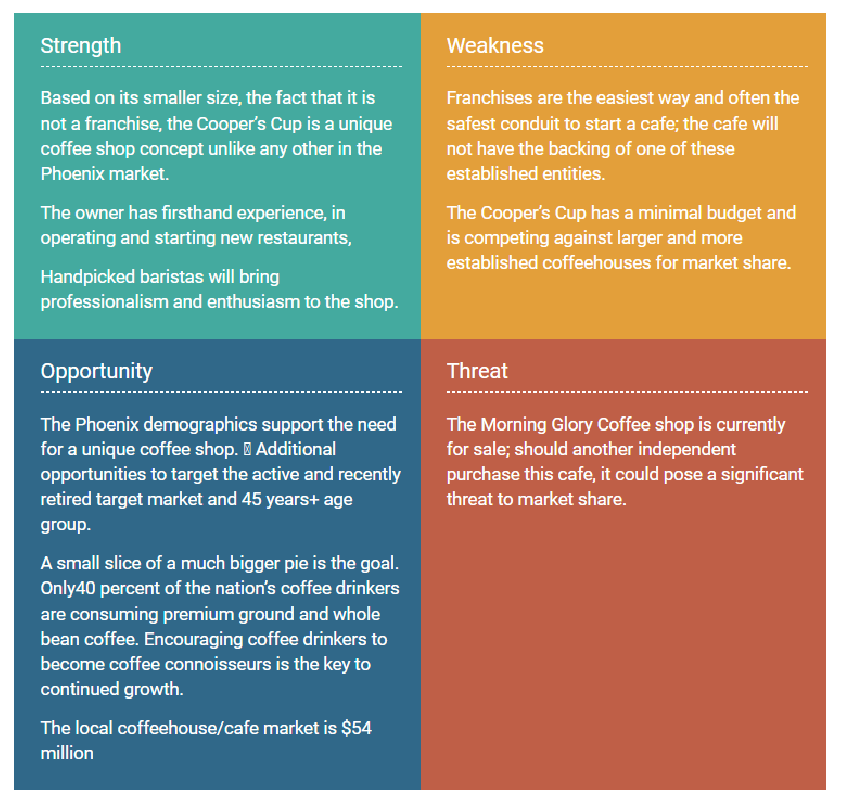
The Cooper’s Cup stands out from a crowded sea of coffee chains and franchises. What sets it apart from the competition is primarily its smaller, cozier size combined with premium coffees served by knowledgeable baristas, providing so much energy and enthusiasm for its products.
The Cooper’s Cup utilizes a focus strategy on its Market. By specifically targeting three primary segments, they can cater specifically to their needs.
The Cooper’s Cup will target this Market simply by its well-selected location. Although this demographic group could readily drive downtown, they prefer a local cafe to unwind and relax and historically become some of the most loyal patrons.
The cafe will attract regular customers (weekly or more) – particularly the newly employed (first job) by providing free WIFI services and providing interesting games in the customer area.
The third targeted Market, younger families, often find that coffeehouse is not ‘kid’ friendly. The company has long-term plans to create a combination coffee shop/play area so that parents and caregivers can meet with other adults while the children can enjoy the bounce houses, slides, and indoor playground equipment.
The Cooper’s Cup primarily utilizes competition-based pricing. The cafe does not utilize coupons and discounts (other than opening promotions) because they believe that the most valuable customer demographic of daily coffee consumers is not influenced by discount programs or coupons.
The Cooper’s Cup will use the following methods to increase sales revenue (as recommended by Andrew Hetzel on Better Coffee, Better Business):
An ongoing training and education program will ensure that each staff member learns and implements Cooper’s Cup’s exacting service and operational procedures standards. Staff meetings will reinforce service standards and principles. The Cafe will have detailed work descriptions and training programs for each position, from entry-level employees to the ongoing development of managers and owners. New employees will undergo an extensive training program. This ensures that each guest receives a quality experience from all employees, regardless of how long they have been employed. The Cafe embraces the concept of promoting from within. Excellence in one function typically leads to excellence in another. Regular staff evaluations and training will ensure motivation and address critical issues.
The founder will be responsible for hiring and training managers who, in turn, will ensure that the day-to-day operations will comply with the standards set by Restaurant policy. Weekly management meetings will provide a forum to review and discuss financial and operational performance. Critical decisions related to purchasing, human resources, marketing, capital expenditures, and customer service will also be addressed.
Food preparation personnel will follow standardized recipes developed by the founders to control food costs and ensure consistency. The coffee shop will offer an innovative menu with nutritious food and beverages while achieving the most significant margin yield.
The hospitality business recognizes the client’s support experience is the critical driver to replicate business. The direction will Offer a superior degree of Professionalism by hiring individuals who deliver the ideal attitude to work and teaching them the skills required to accommodate guests. The restaurant will keep high levels of consumer satisfaction with talented, educated, and well-trained workers who understand and implement the fundamentals of fantastic service. Ongoing training will be provided to enable staff to perform their jobs with confidence and ability. Employees are well-spoken, well-versed, and trained to provide friendly, prompt, and professional service to each customer. This practice teaches employees who, by producing an exceptional customer experience, can optimize sales and raise their reimbursement. The team will have the knowledge and service required to create excellent daily service for every customer.
While the quality of the cuisine and dining experience contributes significantly to a restaurant’s profitability, attention to business and financial details can transform small changes into significant returns. Critical sales, cost of sales, labor, inventory, marketing, and overhead metrics are monitored daily. Trends are evaluated, and constructive actions will be taken where improvement is needed. The management team will have access to the restaurant’s transactions and reports available in its real-time POS (point of sale) and accounting systems. Trends will be evaluated, and corrective action will be implemented as required.
The Cooper’s Cup is formed as an S-Corporation wholly owned by John Doe.
The Cooper’s Cup will be owned 100% by John Doe. Mr. Doe, a graduate of Arizona State University, has an undergraduate degree in business administration. During high school, he worked as a waiter in a local hospital coffee shop that purchased its beans from a local roaster. In addition to being an avid coffee drinker, this job allowed him to learn about the business first-hand. In college, Doe worked in a campus coffeehouse for four years, eventually becoming an assistant manager. Following graduation, Doe secured a business development position for a regional restaurant chain, which provided additional first-hand exposure to the food and beverage industry—especially the steps involved in establishing new locations.
The Cooper’s Cup will rely on its POS (Point of Sale) system to generate daily accounting and cost activity reports. Mr. Doe will supply these to an outside bookkeeper for the preparation of annual income taxes.
Initially, the cafe will hire 1 manager, 5 baristas, and 2 part-time servers. In Year 2, the cafe plans to hire 1 additional full-time barista.
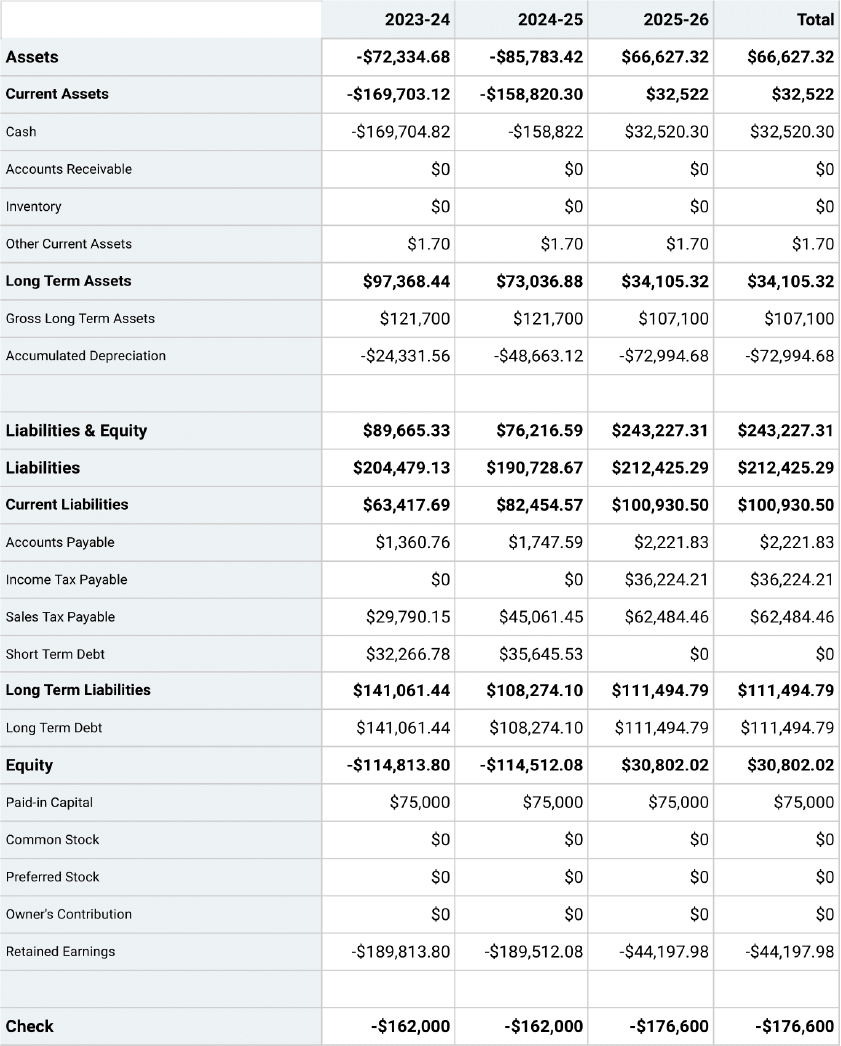
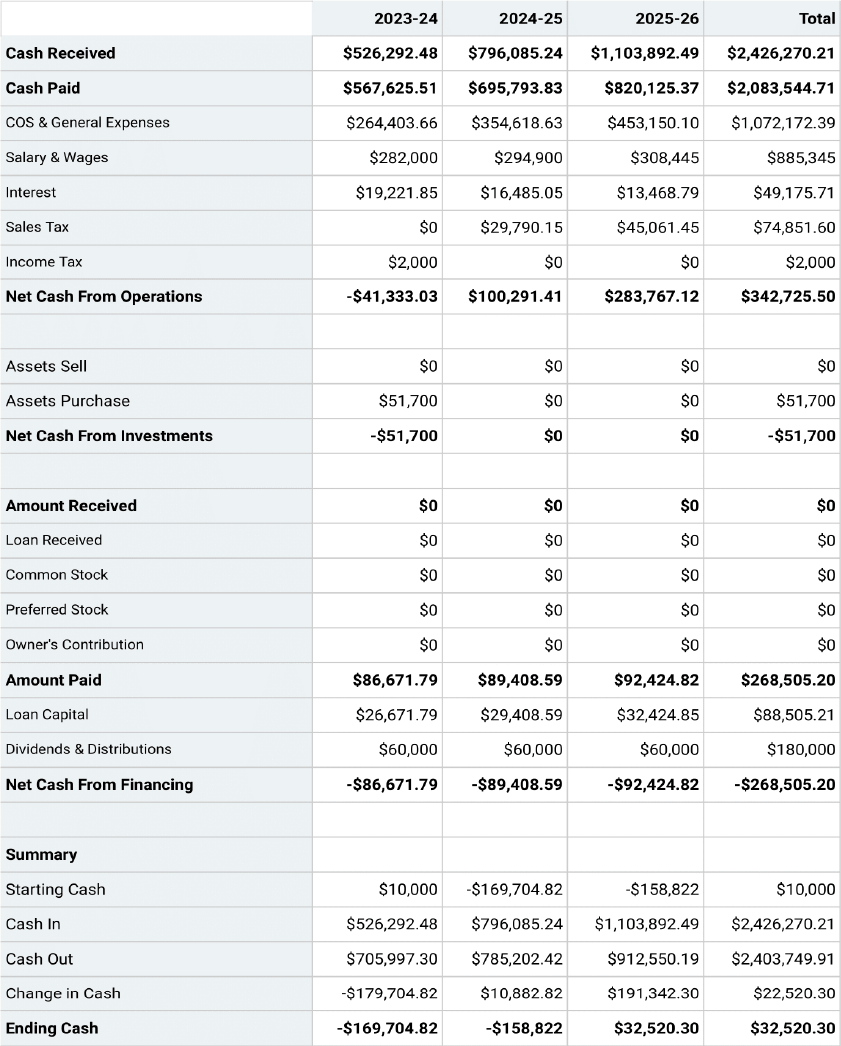
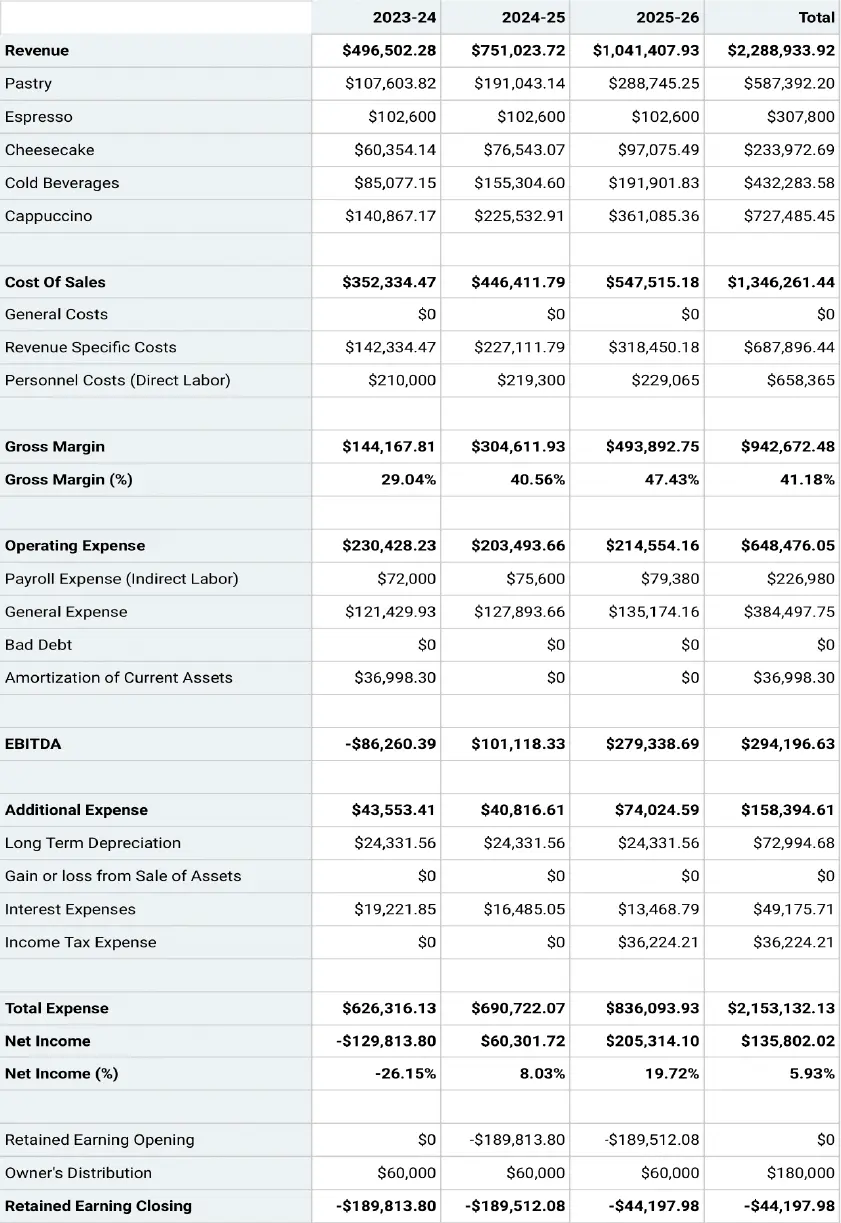
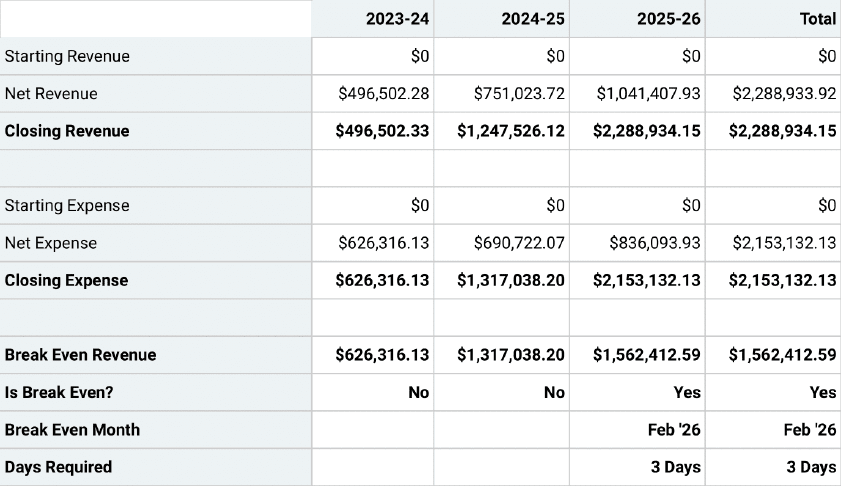
Whether you need a business plan to compete in a competition, win investors, or gain a competitive advantage in the market landscape, Upmetrics can help you get started.
Upmetrics is an AI business plan software that comes with AI assistance, financial forecasting features, and 400+ sample business plans so that you can prepare a business plan in no time.
So what are you waiting for? Try Upmetrics and create your business plan in a snap.
Make your plan in half the time & twice the impact with Upmetrics
Fill-in-the-blanks, AI-assistance, and automatic financials make it easy.